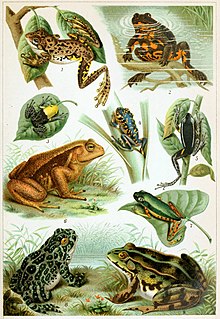
Eastern spadefoot toads is a genus of the family Megophryidae in the order Anura, and are found in southern China, northeast India, Southeast Asia, and islands of the Sunda Shelf as well as the Philippines. They are characterized by a stocky body with slender, short hindlimbs. In identifying species, iris colour is a valuable diagnostic morphological characteristic ; the iris has uniform colour in some species, whereas in other species the upper half is coloured and the lower half is dark.

Leptobrachium hasseltii is a species of toad found in Southeast Asia. According to the current understanding, this species is known with certainty only from Java, Madura, Bali, and Kangean Islands, Indonesia. The species is also commonly reported to occur in the Philippines, but these are believed to refer to another, unnamed species.

Leptobrachium smithi is a species of frog found in Southeast Asia. Its specific name honours Malcolm Arthur Smith, one of the early herpetologists to study the amphibians of Thailand.
Leptobrachium buchardi is a species of amphibian in the family Megophryidae. It is endemic to Laos and only known from the Bolaven Plateau in the Champasak Province, near its type locality within the Dong Hua Sao National Protected Area. Its natural habitat is subtropical or tropical moist montane forests. It is threatened by habitat loss.
Leptobrachium hainanense, the Hainan pseudomoustache toad, is a species of amphibian in the family Megophryidae. It is endemic to the mountains of central and southwestern Hainan Island, China. Before being recognized as a separate species, it was confused with Leptobrachium hasseltii.

Leptobrachium hendricksoni is a species of amphibian in the family Megophryidae. It is found in Malay Peninsula, Sarawak (Borneo), and Sumatra (Indonesia). Its natural habitats are tropical moist lowland forests, rivers, freshwater marshes, and nearby plantations and heavily degraded former forests. It is threatened by habitat loss.

Leptobrachium montanum is a species of frog from the family Megophryidae. It is endemic to Borneo and is, as currently defined, found in Kalimantan (Indonesia), Sabah and Sarawak (Malaysia), and Labi, Belait (Brunei). However, the nominal Leptobrachium montanum is a composed of more than one lineage. Available information mostly refers to this composite rather than the "true" Leptobrachium montanum. Common names montane large-eyed litter frog, mountain spadefoot toad, and mountain litter frog have been coined for it.
Leptobrachium nigrops, also known as the black-eyed litter frog, is a species of amphibian in the family Megophryidae. It is found in Indonesia, Malaysia, and Singapore. Its natural habitats are subtropical or tropical moist lowland forests, subtropical or tropical swamps, and rivers. It is threatened by habitat loss.

Leptobrachium pullum is a species of frog in the family Megophryidae. It is endemic to Vietnam. Its natural habitats are rivers.
Leptobrachium ailaonicum is a species of amphibian in the family Megophryidae. It is found in Yunnan in southern China and on Fansipan mountain in northern Vietnam. Its type locality is Xujiaba in the Ailao Mountains in Jingdong County, Yunnan. At the time of the IUCN assessment in 2004, the population on Fansipan was considered a separate species, Leptobrachium (Vibrissaphora) echinatum, and assessed to be an endangered species.

Leptobrachium boringii, commonly known as the Emei moustache toad or Taosze spiny toad, is a species of amphibian in the family Megophryidae. It is endemic to China where it is found in Sichuan, Guizhou, and Hunan provinces. "Emei" or "Taosze" in its common names refer to its type locality, Taosze on Mount Emei, Sichuan. Its natural habitats are temperate forests, grassland, arable land, and rural gardens near rivers. It is threatened by habitat loss.
Leptobrachium leishanense, the Leishan spiny toad or Leishan moustache toad, is a species of frog in the family Megophryidae. It is endemic to China: it is only known from the vicinity of its type locality in Leishan County in Guizhou. Its natural habitats are moist lowland forests, moist montane forests, and rivers. It is threatened by habitat loss and overexploitation.
Leptobrachium liui, the Chong'an moustache toad or Pope's spiny toad, is a species of frog in the family Megophryidae.
Leptobrachium mouhoti is a species of frog in the family Megophryidae. It is endemic to Vietnam and eastern Cambodia. However, its taxonomic relationship with Leptobrachium pullum, and possible occurrence in Vietnam, is unclear.

Leptobrachium bompu is an extant species of eastern spadefoot toads described in 2011. It is only known from its type locality in the Eaglenest Wildlife Sanctuary in Arunachal Pradesh, Northeast India. The specific name refers to the camp site, Bompu, in the vicinity of the type locality.
Leptobrachium ingeri is a species of frog in the family Megophryidae from Borneo. It was recently distinguished as a separate species from within the Leptobrachium nigrops species complex.
Leptobrachium lumadorum is a species of frog in the family Megophryidae from the islands of Basilan and Mindanao in the Philippines.
Leptobrachium ngoclinhense is a species of frog in the family Megophryidae from Vietnam.
Leptobrachium promustache is a species of frog in the family Megophryidae. It is only known from Mount Dawei in Pingbian Miao Autonomous County, Yunnan, China, near the Vietnamese border, where it is sympatric with the Mount Dawei horned toad.








